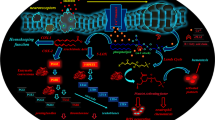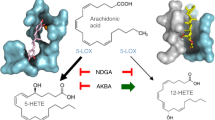Abstract
In response to an inflammatory stimulus, arachidonic acid (AA), the main polyunsaturated fatty acid present in the phospholipid layer of cell membranes, is released and metabolized to a series of eicosanoids. These bioactive lipid mediators of inflammation arise physiologically through the action of the enzymes 5-lipoxygenase (5-LOX) and cyclooxygenases (constitutive COX-1 and inducible COX-2). It is believed that dual inhibition of 5-LOX and COXs may have a higher beneficial impact in the treatment of inflammatory disorders rather than the inhibition of each enzyme. With this demand for new dual-acting anti-inflammatory agents, a range of 2,3-diarylxanthones were tested through their ability to interact in the AA metabolism. In vitro anti-inflammatory activity was evaluated through the inhibition of 5-LOX-catalyzed leukotriene B4 (LTB4) formation in human neutrophils and inhibition of COX-1- and COX-2-catalyzed prostaglandin E2 (PGE2) formation in human whole blood. The results showed that some of the studied arylxanthones were able to prevent LTB4 production in human neutrophils, in a concentration-dependent manner. The xanthone with a 2-catechol was the most active one (IC50 ∼ 9 μM). The more effective arylxanthones in preventing COX-1-catalyzed PGE2 production presented IC50 values from 1 to 7 μM, exhibiting a structural feature with at least one non-substituted aryl group. All the studied arylxanthones were ineffective to prevent the formation of PGE2 catalyzed by COX-2, up to the maximum concentration of 100 μM. The ability of the tested 2,3-diarylxanthones to interact with both 5-LOX and COX-1 pathways constitutes an important step in the research of novel dual-acting anti-inflammatory drugs.




Similar content being viewed by others
References
Ribeiro, D., M. Freitas, J.L.F.C. Lima, and E. Fernandes. 2015. Proinflammatory pathways: the modulation by flavonoids. Medicinal Research Reviews 35: 877–936.
Krishnamoorthy, S., and K.V. Honn. 2006. Inflammation and disease progression. Cancer and Metastasis Reviews 25: 481–491.
Williams, C.S., M. Mann, and R.N. DuBois. 1999. The role of cyclooxygenases in inflammation, cancer, and development. Oncogene 18: 7908–7916.
Bertolini, A., A. Ottani, and M. Sandrini. 2002. Selective COX-2 inhibitors and dual acting anti-inflammatory drugs: critical remarks. Current Medicinal Chemistry 9: 1033–1043.
Leone, S., A. Ottani, and A. Bertolini. 2007. Dual acting anti-inflammatory drugs. Current Topics in Medicinal Chemistry 7: 265–275.
Fiorucci, S., R. Meli, M. Bucci, and G. Cirino. 2001. Dual inhibitors of cyclooxygenase and 5-lipoxygenase. A new avenue in anti-inflammatory therapy? Biochemical Pharmacology 62: 1433–1438.
El-Seedi, H.R., D.M.N. El-Ghorab, M.A. El-Barbary, and M.F. Zayed. 2009. Naturally occurring xanthones; latest investigations: isolation, structure elucidation and chemosystematic significance. Current Medicinal Chemistry 16: 2581–2626.
Panda, S.S., M. Chand, R. Sakhuja, and S.C. Jain. 2013. Xanthones as potential antioxidants. Current Medicinal Chemistry 20: 4481–4507.
Negi, J.S., V.K. Bisht, P. Singh, M.S.M. Rawat, and G.P. Joshi. 2013. Naturally occurring xanthones: chemistry and biology. Journal of Applied Chemistry 2013: 1–9.
El-Seedi, H.R., M.A. El-Barbary, D.M.H. El-Ghorab, L. Bohlin, A.K. Borg-Karlson, et al. 2010. Recent insights into the biosynthesis and biological activities of natural xanthones. Current Medicinal Chemistry 17: 854–901.
Pinto, M.M.M., M.E. Sousa, and M.S.J. Nascimento. 2005. Xanthone derivatives: new insights in biological activities. Current Medicinal Chemistry 12: 2517–2538.
Jiang, D.-J., Z. Dai, and Y.-J. Li. 2004. Pharmacological effects of xanthones as cardiovascular protective agents. Cardiovascular Drug Reviews 22: 91–102.
Santos, C.M.M., D.C.G.A. Pinto, V.L.M. Silva, and A.M.S. Silva. 2016. Arylxanthones and arylacridones: a synthetic overview. Pure and Applied Chemistry 88: 579–594.
Santos, C.M.M., M. Freitas, D. Ribeiro, A. Gomes, A.M.S. Silva, et al. 2010. 2,3-Diarylxanthones as strong scavengers of reactive oxygen and nitrogen species: a structure–activity relationship study. Bioorganic and Medicinal Chemistry 18: 6776–6784.
Proença, C., H.M.T. Albuquerque, D. Ribeiro, M. Freitas, C.M.M. Santos, et al. 2016. Novel chromone and xanthone derivatives: synthesis and ROS/RNS scavenging activities. European Journal of Medicinal Chemistry 115: 381–392.
Santos, C.M.M., A.M.S. Silva, P. Filipe, R. Santus, L.K. Patterson, et al. 2011. Structure–activity relationships in hydroxy-2,3-diarylxanthone antioxidants. Fast kinetics spectroscopy as a tool to evaluate the potential for antioxidant activity in biological systems. Organic and Biomolecular Chemistry 9: 3965–3974.
Carvalho, L.C.R., D. Ribeiro, R.S.G.R. Seixas, A.M.S. Silva, M. Nave, et al. 2015. Synthesis and evaluation of new benzimidazole based COX inhibitors: a naproxen-like interaction detected by STD-NMR. RSC Advances 5: 49098–49109.
Santos, C.M.M., A.M.S., Silva, and J.A.S., Cavaleiro. 2009. Efficient syntheses of new polyhydroxylated 2,3-diaryl-9H-xanthen-9-ones. European Journal of Organic Chemistry 2009: 2642-2660.
Freitas, M., G. Porto, J.L. Lima, and E. Fernandes. 2008. Isolation and activation of human neutrophils in vitro. The importance of the anticoagulant used during blood collection. Clinical Biochemistry 41: 570–575.
Gomes, A., E. Fernandes, A.M.S. Silva, D.C.G.A. Pinto, C.M.M. Santos, et al. 2009. Anti-inflammatory potential of 2-styrylchromones regarding their interference with arachidonic acid metabolic pathways. Biochemical Pharmacology 78: 171–177.
Laufer, S., and S. Luik. 2010. Different methods for testing potential cyclooxygenase-1 and cyclooxygenase-2 inhibitors. In: Ayoub SS, editor. Cyclooxygenases: methods and protocols, 644th ed, 91–116. Philadelphia: Springer Science + Business Media, LLC.
Ribeiro, D., M. Freitas, S.M. Tomé, A.M.S. Silva, S. Laufer, et al. 2015. Flavonoids inhibit COX-1 and COX-2 enzymes and cytokine/chemokine production in human whole blood. Inflammation 38: 858–870.
Laufer, S., C. Greim, S. Luik, S.S. Ayoub, and F. Dehner. 2008. Human whole blood assay for rapid and routine testing of nonsteroidal anti-inflammatory drugs (NSAIDs) on cyclo-oxygenase-2 activity. Inflammopharmacology 16: 155–161.
Ribeiro, D., M. Freitas, S.M. Tomé, A.M.S. Silva, G. Porto, et al. 2014. Inhibition of LOX by flavonoids: a structure-activity relationship study. European Journal of Medicinal Chemistry 72: 137–145.
Sadik, C.D., H. Sies, and T. Schewe. 2003. Inhibition of 15-lipoxygenases by flavonoids: structure-activity relations and mode of action. Biochemical Pharmacology 65: 773–781.
Hsu, M.-F., C.-N. Lin, M.-C. Lu, and J.-P. Wang. 2004. Inhibition of the arachidonic acid cascade by norathyriol via blockade of cyclooxygenase and lipoxygenase activity in neutrophils. Naunyn-Schmiedeberg’s Archives in Pharmacolology 369: 507–515.
Garrido, G., D. González, Y. Lemus, C. Delporte, and R. Delgado. 2006. Protective effects of a standard extract of Mangifera indica L. (VIMANGs) against mouse ear edemas and its inhibition of eicosanoid production in J774 murine macrophages. Phytomedicine 13: 412–418.
Garrido, G., D. González, Y. Lemus, D. García, L. Lodeiro, et al. 2004. In vivo and in vitro anti-inflammatory activity of Mangifera indica L. extract (VIMANG®). Pharmarcological Research 50: 143–149.
Crockett, S.L., B. Poller, N. Tabanca, E.-M. Pferschy-Wenzig, O. Kunert, et al. 2011. Bioactive xanthones from the roots of Hypericum perforatum (common St John’s wort). Journal of the Science Food Agriculture 91: 428–434.
Werz, O., and D. Steinhilber. 2005. Development of 5-lipoxygenase inhibitors-lessons from cellular enzyme regulation. Biochemical Pharmacology 70: 327–333.
Nelson, M.J., D.G. Batt, J.S. Thompson, and S.W. Wright. 1991. Reduction of the active-site iron by potent inhibitors of lipoxygenases. Journal of Biological Chemistry 266: 8225–8229.
Rouzer, C.A., and B., Samuelsson. 1986. The importance of hydroperoxide activation for the detection and assay of mammalian 5-lipoxygenase. FEBS Letters 204: 293-296.
Waller, C.P., A.E. Thumser, M.K. Langat, N.R. Crouch, and D.A. Mulholland. 2013. COX-2 inhibitory activity of homoisoflavanones and xanthones from the bulbs of the southern African Ledebouria socialis and Ledebouria ovatifolia (Hyacinthaceae: Hyacinthoideae). Phytochemistry 95: 284–290.
Nakatani, K., N. Nakahata, T. Arakawa, H. Yasuda, and Y. Ohizumi. 2002. Inhibition of cyclooxygenase and prostaglandin E2 synthesis by γ-mangostin, a xanthone derivative in mangosteen, in C6 rat glioma cells. Biochemical Pharmacology 63: 73–79.
Yamakuni, T., K. Aoki, K. Nakatani, N. Kondo, H. Oku, et al. 2006. Garcinone B reduces prostaglandin E2 release and NF-kB-mediated transcription in C6 rat glioma cells. Neuroscience Letters 394: 206–210.
Tewtrakul, S., C. Wattanapiromsakul, and W. Mahabusarakam. 2009. Effects of compounds from Garcinia mangostana on inflammatory mediators in RAW264.7 macrophage cells. Journal of Ethnopharmacology 121: 379–382.
Syam, S., A. Bustamam, R. Abdullah, M.A. Sukari, N.M. Hashim, et al. 2014. β Mangostin suppress LPS-induced inflammatory response in RAW 264.7 macrophages in vitro and carrageenan-induced peritonitis in vivo. Journal of Ethnopharmacology 153: 435–445.
Acknowledgements
Sincere thanks are expressed to Faculdade de Farmácia da Universidade do Porto, Universidade de Aveiro, Instituto Politécnico de Bragança, Fundação para a Ciência e a Tecnologia (FCT, Portugal), Ministério da Educação e Ciência, European Union, FEDER, PT 2020, QREN, and COMPETE funding UCIBIO, REQUIMTE [(PT2020 UID/MULTI/04378/2013 - POCI/01/0145/FEDER/007728), (NORTE-01-0145-FEDER-000024), and (PTDC/QEQ-QAN/1742/2014 – POCI-01-0145-FEDER-016530)] and QOPNA (FCT UID/QUI/00062/2013) Research Units and also to the Portuguese National NMR Network (RNRMN). We gratefully acknowledge Graça Porto and the nursing staff of the Centro Hospitalar do Porto - Hospital de Santo António blood bank for the collaboration in the recruitment of blood donors involved in the present work.
Author information
Authors and Affiliations
Corresponding authors
Rights and permissions
About this article
Cite this article
Santos, C.M.M., Ribeiro, D., Silva, A.M.S. et al. 2,3-Diarylxanthones as Potential Inhibitors of Arachidonic Acid Metabolic Pathways. Inflammation 40, 956–964 (2017). https://doi.org/10.1007/s10753-017-0540-6
Published:
Issue Date:
DOI: https://doi.org/10.1007/s10753-017-0540-6




